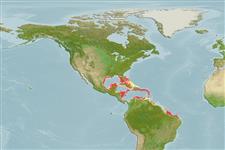>
Ovalentaria/misc (Various families in series Ovalentaria) >
Pomacentridae (Damselfishes) > Chrominae
Etymology: Chromis: Greek, chromis = a fish, perhaps a perch (Ref. 45335).
Environment: milieu / climate zone / depth range / distribution range
Ecología
marino asociado a arrecife; no migratorio; rango de profundidad 15 - 116 m (Ref. 13442), usually 15 - 30 m (Ref. 9710). Tropical; 35°N - 23°S, 100°W - 34°W
Western Atlantic: southern Florida, USA and the Caribbean Sea (Ref. 7247) to northern Brazil (Ref. 57756). More abundant at continental locations (Ref. 51183).
Tamaño / Peso / Age
Maturity: Lm ? range ? - ? cm
Max length : 10.0 cm TL macho / no sexado; (Ref. 9710)
Short description
Claves de identificación | Morfología | Morfometría
Espinas dorsales (total) : 13; Radios blandos dorsales (total) : 11 - 12; Espinas anales: 2; Radios blandos anales: 11 - 12. Adults gray brown dorsally, often shading white ventrally, with purple- blue markings, many as vertical lines; upper edge of eye bright purple-blue; juveniles blue (Ref. 13442).
Adults occur in steep outer slopes and deeper patch reefs (Ref. 7247). Oviparous, distinct pairing during breeding (Ref. 205). Eggs are demersal and adhere to the substrate (Ref. 205). Males guard and aerate the eggs (Ref. 205).
Life cycle and mating behavior
Maturities | Reproducción | Spawnings | Egg(s) | Fecundities | Larva
Oviparous, distinct pairing during breeding (Ref. 205). Eggs are demersal and adhere to the substrate (Ref. 205). Males guard and aerate the eggs (Ref. 205).
Allen, G.R., 1991. Damselfishes of the world. Mergus Publishers, Melle, Germany. 271 p. (Ref. 7247)
IUCN Red List Status (Ref. 130435)
Threat to humans
Harmless
Human uses
Pesquerías: comercial; Acuario: Comercial
Herramientas
Special reports
Download XML
Fuentes de Internet
Estimates based on models
Preferred temperature (Ref.
123201): 23.9 - 28, mean 26.8 °C (based on 126 cells).
Phylogenetic diversity index (Ref.
82804): PD
50 = 0.5000 [Uniqueness, from 0.5 = low to 2.0 = high].
Bayesian length-weight: a=0.01778 (0.00796 - 0.03971), b=2.99 (2.81 - 3.17), in cm total length, based on LWR estimates for this Genus-body shape (Ref.
93245).
Nivel trófico (Ref.
69278): 3.4 ±0.45 se; based on food items.
Resiliencia (Ref.
120179): Alto, población duplicada en un tiempo mínimo inferior a 15 meses (Preliminary K or Fecundity.).
Fishing Vulnerability (Ref.
59153): Low vulnerability (10 of 100).
Nutrients (Ref.
124155): Calcium = 109 [52, 172] mg/100g; Iron = 0.848 [0.493, 1.437] mg/100g; Protein = 18.2 [16.9, 19.4] %; Omega3 = 0.142 [0.080, 0.246] g/100g; Selenium = 29.6 [14.8, 60.0] μg/100g; VitaminA = 147 [42, 500] μg/100g; Zinc = 1.4 [0.9, 2.0] mg/100g (wet weight);
